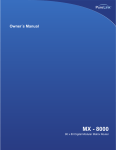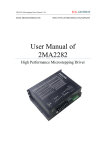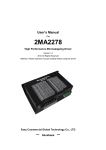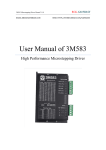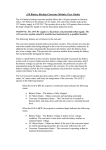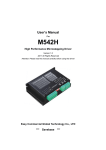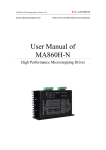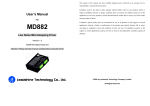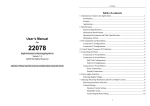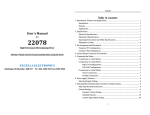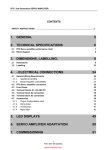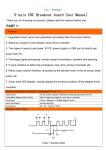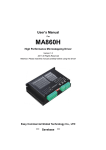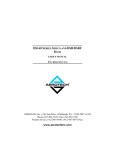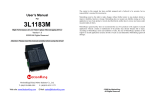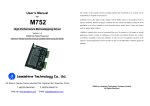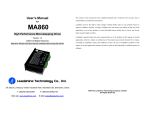Download User Manual of 3MA2283
Transcript
3MA2283 Microstepping Driver Manual V1.0 EMAIL:[email protected] ECG-SAVEBASE WEB: HTTP://STORES.EBAY.CO.UK/SAVEBASE User Manual of 3MA2283 High Performance Microstepping Driver 3MA2283 Microstepping Driver Manual V1.0 ECG-SAVEBASE ECG Safety Statement Easy Commercial Global is not liable or responsible for any accidents, injuries, equipment damage, property damage, loss of money or loss of time resulting from improper use of electrical or mechanical or software products sold on this website or other Easy Commercial Global sales resources. Since Easy Commercial Global basically provide OEM machine builders components to build their machines for their own use or third party use it is their responsibility to maintain certify and comply the end user products built base on out components sold on this website or other Easy Commercial Global sales resources. Assembling electrical CNC machine component like power supplies, motors, drivers or other electrical components involve dealing with high voltage like AC alternative current or DC direct current which is extremely dangerous and need high attention & essential experience and knowledge of software, electricity, electro-mechanics or mechanics. For technical question please contact us at [email protected] before purchase. 2011 Easy Commercial Global Technology Corporation Limited All Rights Reserved 3MA2283 Microstepping Driver Manual V1.0 ECG--SAVEBASE Contents 1 2 3 Introduction, Features and Application ..................................................................................... 1 1.1 Introduction ................................................................................................................... 1 1.2 Features ......................................................................................................................... 1 1.3 Application .................................................................................................................... 1 Specifications ............................................................................................................................ 2 2.1 Electrical Specifications ................................................................................................ 2 2.2 Operating Environment & Other Specifications ........................................................... 2 2.3 Mechanical Specification .............................................................................................. 2 Pin Assignment and Description ............................................................................................. 3 3.1 Connector P1 Configurations ........................................................................................ 4 3.2 Connector P2 Configurations ........................................................................................ 4 4 Connections to Stepping Motors ............................................................................................... 4 5 Microstep Resolution and Output Current Settings .................................................................. 5 6 5.1 Microstep Resolution Selection .................................................................................... 5 5.2 Current Settings............................................................................................................. 6 5.2.1 Dynamic Current Setting................................................................................... 6 5.2.2 Standstill Current Setting .................................................................................. 7 Wiring Notes ............................................................................................................................. 7 3MA2283 Microstepping Driver Manual V1.0 ECG--SAVEBASE 7 Typical Connection ................................................................................................................... 7 8 Sequence Chart of Control Signals ........................................................................................... 8 9 Protection Functions ................................................................................................................. 9 10 Frequently Asked Questions ..................................................................................................... 9 3MA2283 Microstepping Driver Manual V1.0 ECG-SAVEBASE 1 Introduction, Features and Application 1.1 Introduction The 3MA2283 is a high performance and low noise microstepping driver based on pure-sinusoidal current control technology. It is suitable for driving 3-phas hybrid stepping motors. By using advanced bipolar constant-current chopping technique, this driver can output more torque than other drivers at high speed. The microstep capability allows stepping motors to run at higher smoothness, less vibration and lower noise. It’s pure-sinusoidal current control technology allows coil current to be well controlled with relatively small current ripple, therefore smaller motor noise and less motor heating can be achieved. 1.2 1.3 Features High quality, cost-effective Low motor & driver heating Supply voltage "150V AC to 220V(peak) AC" or "210V DC to 310V(peak) DC" Output current up from 2A to 8.3A TTL compatible and optic-isolated inputs Automatic idle-current reduction Input frequency up to 400 KHz 16 microstep resolutions selectable Suitable for 3-phase stepping motors DIP switch microstep & current settings Support PUL/DIR & CW/CCW modes Application Suitable for large and medium automation machines and devices, such as engraving machines, labeling machines, cutting machines, laser phototypesetting systems, plotting instruments, CNC Lathe, pick-place devices, and so on. Particularly adapt to the applications desired with low noise, low vibration, high speed and high precision. 1 ECG--SAVEBASE 3MA2283 Microstepping Driver Manual V1.0 2 Specifications 2.1 Electrical Specifications Parameters 3MA2283 Min Typical Max Unit Output current 2 - 8.3(5.9A RMS) A Supply voltage 150 180 220 VAC 7 10 16 mA 0 - 400 KHz Logic signal current Pulse input frequency Isolation resistance 500 MΩ 2.2 Operating Environment & Other Specifications Natural Cooling or Forced cooling Cooling Avoid dust, oil fog and Environment Operating Environment corrosive gases Ambient Temperature 0 ℃- 50℃ (32℉ - 122 ℉) Humidity 40%RH - 90%RH Operating Temperature 70℃ (158℉) Max Vibration 5.9m/s2 Max Storage Temperature -20 ℃ - 65℃ (-4℉ - 149℉) Weight Approx. 1500g 2.3 Mechanical Specification Unit = mm, 1 inch = 25.4 mm 2 3MA2283 Microstepping Driver Manual V1.0 ECG--SAVEBASE Figure 2-1 Mechanical Specifications Note: Recommend use side mounting for better heat dissipation Elimination of Heat Reliable working temperature of driver should be <70℃(158℉), and motor working temperature should be <80℃(176℉); It is recommended to use automatic idle-current mode, namely current automatically reduce to 60% when motor stops, so as to reduce driver heating and motor heating; It is recommended to mount the driver vertically to maximize heat sink area. Use forced cooling method to cool the system if necessary. 3 Pin Assignment and Description The 3M583 has two connectors, connector P1 for control signals connections, and connector P2 for power and motor connections. The following tables are brief descriptions of the two connectors. More detailed descriptions of the pins and related issues are presented in section 4, 5, 9. 3 ECG--SAVEBASE 3MA2283 Microstepping Driver Manual V1.0 3.1 Connector P1 Configurations Pin Function Details PUL+ Pulse signal: In single pulse (pulse/direction) mode, this input represents pulse signal, effective for each rising edge; 4-5V when PUL-HIGH, 0-0.5V when PUL-LOW. In double pulse mode PUL- (pulse/pulse) , this input represents clockwise (CW) pulse,effective for high level. For reliable response, pulse width should be longer than 1.2μs. Series connect resistors for current-limiting when +12V or +24V used. DIR+ representing two directions of motor rotation; in double-pulse mode(set by inside jumper), this signal is counter-clock (CCW) pulse, effective for high level. For reliable motion response, DIR signal should be ahead of PUL signal by 5μs at least. 4-5V when DIR-HIGH, 0-0.5V when DIR- DIR-LOW. Please note that motion direction is also related to motor-driver wiring match. Exchanging the connection of two wires for a coil to the driver will reverse motion direction. ENA+ (NPN control signal, PNP and Differential control signals are on the contrary, namely Low level ENA- for enabling.) for enabling the driver and low level for disabling the driver. Usually left UNCONNECTED (ENABLED). FAULT+ Fault signal positive: FAULT+ is an opto-coupler output from open-collector circuit, maximum permitted input voltage is 30VDC; maximum output current 20mA. It generally can be serial connected to PLC input terminal. Fault signal negative. FAULT- 3.2 Connector P2 Configurations Pin Function Details AC AC power supply inputs. Recommend use isolation transformers with theoretical output AC voltage of 150~220 VAC, leaving room for power fluctuation and back-EMF. U、V、W Motor Phase U、V、W PE Ground terminal. Recommend connect this port to the ground for better safety. Remark: Please note that motion direction is also related to motor-driver wiring matches. Exchanging the connections of two phases to the driver will reverse motor motion direction. 4 Connections to Stepping Motors The connection between the driver and 3-phase stepping motors includes two different kinds of connections, namely delta-connection and star-connection. Using delta-connection, the 4 ECG--SAVEBASE 3MA2283 Microstepping Driver Manual V1.0 performances of the motor under high speed condition are better, but the driver current is higher too (about 1.73 times the motor coil current); while using star-connection, the driver current equals to the motor coil current. Figure 4-1 Motor connections 5 Microstep Resolution and Output Current Settings This driver uses a 8-bit DIP switch to set microstep resolution, motor operating current and control signal mode: 5.1 Microstep Resolution Selection Microstep resolution is set by SW5, 6, 7 and 8 of the DIP switch as shown in the following table: Steps/rev.(for1.2° SW5 SW6 SW7 SW8 200 ON ON ON ON 400 OFF ON ON ON 1600 ON OFF ON ON 3200 OFF OFF ON ON 6400 ON ON OFF ON 12800 OFF ON OFF ON 25600 ON OFF OFF ON 600 OFF OFF OFF ON 1000 ON ON ON OFF 1200 OFF ON ON OFF 2000 ON OFF ON OFF motor) 5 ECG--SAVEBASE 3MA2283 Microstepping Driver Manual V1.0 4000 OFF OFF ON OFF 5000 ON ON OFF OFF 6000 OFF ON OFF OFF 8000 ON OFF OFF OFF 10000 OFF OFF OFF OFF 5.2 Current Settings For a given motor, higher driver current will make the motor output more torque, but at the same time causes more heating in the motor and driver. Therefore, output current is generally set to be such that the motor will not overheat for long time operation. Phase current rating supplied by motor manufacturer is important in selecting driver current, however the selection also depends on leads and connections. 5.2.1 Dynamic Current Setting The first four bits (SW1, 2, 3, 4) of the DIP switch are used to set the dynamic current. Select a setting closest to your motor’s required current. Peak current(A) RMS(A) SW1 SW2 SW3 SW4 2.0 1.41 OFF OFF OFF OFF 2.4 1.70 ON OFF OFF OFF 2.8 1.98 OFF ON OFF OFF 3.2 2.26 ON ON OFF OFF 3.6 2.55 OFF OFF ON OFF 4.2 2.97 ON OFF ON OFF 4.8 3.39 OFF ON ON OFF 5.2 3.68 ON ON ON OFF 5.6 3.96 OFF OFF OFF ON 6.0 4.24 ON OFF OFF ON 6.4 4.53 OFF ON OFF ON 6.8 4.81 ON ON OFF ON 7.2 5.09 OFF OFF ON ON 7.6 5.37 ON OFF ON ON 8.0 5.66 OFF ON ON ON 8.3 5.80 ON ON ON ON 6 3MA2283 Microstepping Driver Manual V1.0 ECG--SAVEBASE Notes: Due to motor inductance, the actual current in the coil may be smaller than the dynamic current setting, particularly under high speed condition. 5.2.2 Standstill Current Setting The 3MA2283 has automatic idle-current reduction function. The current automatically be reduced to 60% of the selected dynamic current setting 0.2 second after the last pulse. Theoretically, this will reduce motor heating to 36% (due to P=I2*R) of the original value. 6 Wiring Notes In order to improve anti-interference performance of the driver, it is recommended to use twisted pair shield cable. To prevent noise incurred in PUL/DIR signal, pulse/direction signal wires and motor wires should not be tied up together. It is better to separate them by at least 10 cm; otherwise the disturbing signals generated by motor will easily disturb pulse direction signals, causing motor position error, system instability and other failures. If a power supply serves several drivers, separately connecting the drivers is recommended instead of daisy-chaining. It is prohibited to pull and plug connector P2 while the driver is powered ON, because there is high current flowing through motor coils (even when motor is at standstill). Pulling or plugging connector P2 with power on will cause extremely high back-EMF voltage surge, which may damage the driver. 7 Typical Connection A complete stepping system should include stepping motor, stepping driver, power supply and controller (pulse generator). A typical connection is shown as figure. 7 3MA2283 Microstepping Driver Manual V1.0 ECG--SAVEBASE 3MA2283 Figure 7-1: Typical connection 8 Sequence Chart of Control Signals In order to avoid some fault operations and deviations, PUL, DIR and ENA should abide by some rules, shown as following diagram: Figure 8-1: Sequence chart of control signals 8 3MA2283 Microstepping Driver Manual V1.0 ECG--SAVEBASE Remark: (1) t1: ENA must be ahead of DIR by at least 5μs. Usually, ENA+ and ENA- are NC (not connected). See “Connector P1 Configurations” for more information. (2) t2: DIR must be ahead of PUL effective edge by at least 5μs to ensure correct direction; (3) t3: Pulse width not less than 1.5μs; (4) t4: Low level width not less than 1.5μs. 9 Protection Functions To improve reliability, the driver incorporates some built-in protections features. Short-voltage and Over-voltage protection When power supply voltage exceeds 286VAC or 405VDC, over-voltage protection will be activated and the RED ALARM LED will light. When power supply voltage is lower than 56VAC or 80VDC, short-voltage protection will be activated and the RED ALARM LED will light. Over-current Protection Protection will be activated in case of over current which may otherwise damage the driver. Attention: Since there is no protection against power leads (+, -) reversal, it is critical to make sure that power supply leads correctly connected to the driver. Otherwise, the driver will be damaged instantly. Note: When above protections are active, the motor shaft will be free and the RED ALARM LED will light. Reset the driver by repowering it to make it function properly after removing above problems. 10 Frequently Asked Questions In the event that your driver does not operate properly, the first step is to identify whether the problem is electrical or mechanical in nature. The next step is to isolate the system component that is causing the problem. As part of this process you may have to disconnect the individual components that make up your system and verify that they operate independently. It is important 9 3MA2283 Microstepping Driver Manual V1.0 ECG--SAVEBASE to document each step in the troubleshooting process. Many of the problems that affect motion control systems can be traced to electrical noise, controller software errors, or mistake in wiring. Problem Symptoms and Possible Causes Symptoms Possible Problems Microstep resolution setting is wrong DIP switch current setting is wrong Motor is not rotating Fault condition exists The driver is disable Motor rotates in the wrong direction Motor phase may be connected in reverse DIP switch current setting is wrong The driver in fault Something wrong with motor coil Control signal is too weak Control signal is interfered Erratic motor motion Wrong motor connection Something wrong with motor coil Current setting is too small, losing steps Current setting is too small Motor is undersized for the application Motor stalls during acceleration Acceleration is set too high Power supply voltage too low Inadequate heat sinking/cooling Excessive motor and driver heating Automatic current reduction function not being utilized Current is set too high 10















